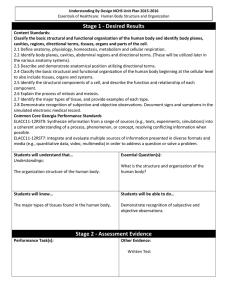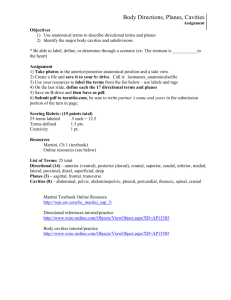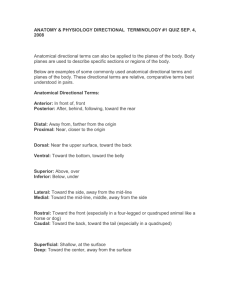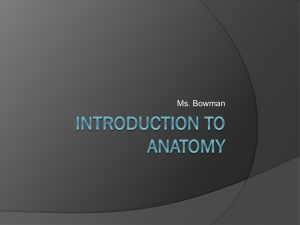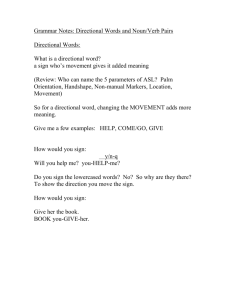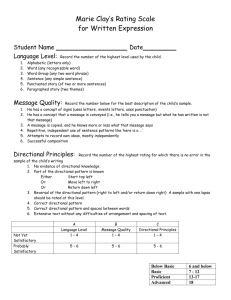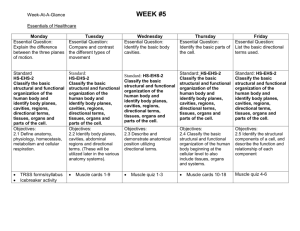Chapter 1 Notes
advertisement
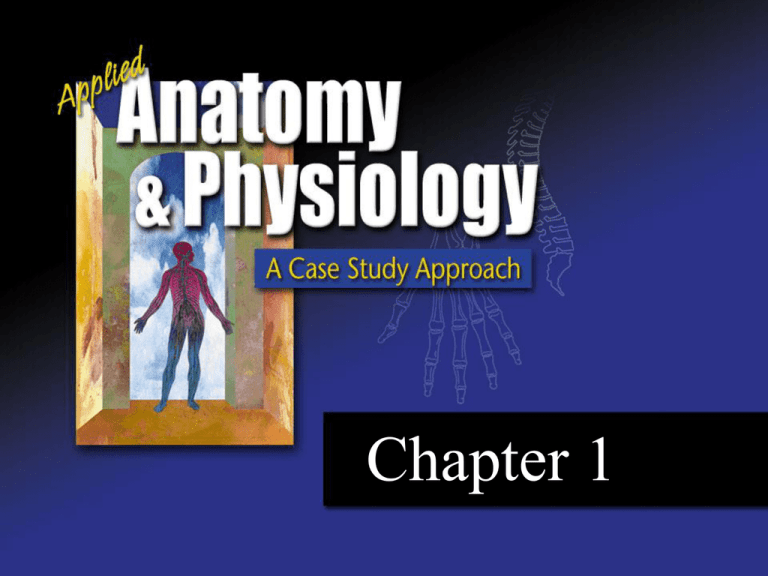
Chapter 1 Applied Learning Outcomes Directional terms describe: • the relative location of different body features • the ways the body can be viewed along imaginary lines Chapter 1 – Overview of the Body Human Body Orientation Directional orientation •explains a particular view of a person Directional planes •views of imaginary lines sliced through a person Chapter 1 – Overview of the Body DIRECTIONAL ORIENTATION Directional orientation explains a particular view of a person. •Medial refers to the middle of the body. •Lateral refers to the sides of the body. •Superior, or cephalic, refers to a location near the head. Chapter 1 – Overview of the Body DIRECTIONAL ORIENTATION •Inferior, or caudal, refers to a location near the feet. •Anterior, or ventral, refers to the front of the human body. •Posterior, or dorsal, refers to the back of the human body. Chapter 1 – Overview of the Body Directional planes Directional planes are views of imaginary lines sliced through a person. •A sagittal section slices the body vertically into left and right sections. •A midsagittal section slices the body into equal left and right halves. Chapter 1 – Overview of the Body Directional planes •A frontal, or coronal, section slices the body vertically into anterior and posterior sections. •A transverse section slices the body horizontally into inferior and superior sections. Chapter 1 – Overview of the Body Chapter 1 – Overview of the Body Human Body Orientation Flexion: to bend a joint Extension: to straighten a joint Chapter 1 – Overview of the Body Human Body Orientation Abduction: movement of the arm or leg away from the midline of the body Adduction: movement of the arm or leg toward the midline of the body Chapter 1 – Overview of the Body Human Body Orientation Eversion: movement of the hand or foot so that the thumb or great toe moves away from the midline of the body Inversion: movement of the hand or foot so that the thumb or great toe moves toward the midline of the body Chapter 1 – Overview of the Body Human Body Orientation • Antagonistic: Opposing movements Flexion Extension Abduction Adduction Inversion Eversion Chapter 1 – Overview of the Body Body Regions and Cavities • Body regions are divided into general locations, abdominopelvic regions, and quadrants Chapter 1 – Overview of the Body Body Regions and Cavities • Abdominopelvic regions include nine sections that divide up the abdominal and pelvic portions of the body. Chapter 1 – Overview of the Body Body Regions and Cavities • Quadrants section the abdominal region into four portions. Body Regions and Cavities • The human body is naturally divided into internal cavities • The body cavities contain specific body structures. (You will receive a list of these structures later) Chapter 1 – Overview of the Body Summary Directional terms describe • the relative location of different body features • the ways the body can be viewed along imaginary lines Position terms explain • how a patient should be positioned for a procedure Movement terms explain • a person’s ability to move a body structure in a particular direction in relation to the center of the body Body region terms • create a map of the body locations • describe the location of pain or injury Body cavity terms • create a map of the body structures • help healthcare workers communicate accurately and effectively Chapter 1 – Overview of the Body
